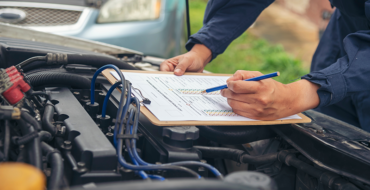Vehicle temperature is not only important for keeping yourself and your passengers comfortable, but also for keeping your car’s engine in good condition. To avoid expensive repairs, use these tips to help you deal with any issues with your heating and cooling system early on.
Common Heating and Cooling Issues

How Is Temperature Regulated?
Most car engines circulate coolant (a mixture of water and antifreeze) through cooling passages to maintain a certain temperature. When the engine is hot, the coolant picks up the heat, carries it through the radiator, and sends the excess to the outside air. When the engine is cold, the coolant doesn’t move. Instead, the thermostat opens to allow the engine to warm up.
The ideal temperature for a vehicle’s engine varies based on the model. A typical average is between 75 and 105 degrees Celsius. If the temperature is far outside of this range, the engine may be at risk of running cold or overheating.
Symptoms of Running Cold
In the winter months, your car’s heater has the important job of keeping you warm on your commutes. Sometimes, the engine’s temperature may be too low to heat the cabin.
Here are some signs your engine may be running cold:
- The temperature gauge is reading very low.
- Only cool air is coming out of the heater.
- The fuel economy has dropped.
Running cold is typically not as dangerous as overheating, but it should still be taken seriously and addressed right away to prevent further damage. We’ll mention a few possible causes and solutions farther down.
Symptoms of Overheating
When it’s hot outside, A/C can make all the difference in getting your legs unstuck from your car’s seats. If your car starts to feel like a sauna in the summer, your engine may be too warm.
Here are some indicators of an engine that’s overheating:
- The temperature gauge is reading very high.
- The temperature warning light is on.
- The engine is making thumping or ticking sounds.
- Coolant has leaked on the ground below the vehicle.
- The hood is extremely hot.
If you notice any of these symptoms, turn your engine off immediately and let it cool down. Once the engine has cooled, you can investigate the issue. Driving with an overheated engine can cause serious and potentially permanent damage. If the damage is beyond repair, you’ll have to get your engine replaced. That can cost upwards of $4,000, so do yourself a favour and don’t push your engine if you think it’s overheating!
Causes and Solutions
If your car has one or more of the above symptoms, you’ll need to troubleshoot for a potential temperature issue. Always use proper PPE when doing any vehicle inspection or maintenance.
Low Coolant Level
A low coolant level can cause the engine to be either too cold or too hot. Sometimes, all you need to do is refill the coolant reservoir and give it some time to soak in. In other cases, there may be a leak in the cooling system that needs attention. Inspect all the parts of the engine cooling system, including the coolant hose, for leaks.
Failed Water Pump
Issues with the water pump can also impact your car’s ability to regulate temperature. Common water pump issues include a leak in the shaft or a loose hub. If something looks off with your water pump, you may need to replace it.
Faulty Radiator
A damaged radiator is a common cause of a coolant leak in a vehicle. There may be a loose clamp by the radiator that needs tightening, or the radiator hose may need replacing. If neither of those is the issue, you may need to pour a stop-leak product into the radiator to fill any holes in the cooling system.
Thermostat Issue
A working thermostat is crucial to maintain engine temperature, ensure good fuel economy, and reduce emissions. If the temperature gauge is reading extremely high or low, you may need to replace the thermostat. You can also test the thermostat by dropping it into a bucket of boiling water to make sure it opens up. If it remains closed, it needs replacing.
Clogged Heater Core
If you’re getting little to no airflow in your car, the heater core may be clogged. To resolve this, you’ll need to disconnect the heater hoses and use water and/or an air compressor to flush out the heater core. Once the core is dry, reattach the hoses and refill the coolant reservoir.
If you’re unsure what’s wrong with your vehicle’s engine, visit a NAPA AUTOPRO service centre to have it assessed by a professional.
Maintaining Your Vehicle
The best way to prevent issues with your vehicle, including with the heating and cooling system, is to stay on top of your maintenance routine. Perform a maintenance check on the cooling system every couple of years to make sure everything is running as it should.
For more automotive maintenance tips, check out our blog.








